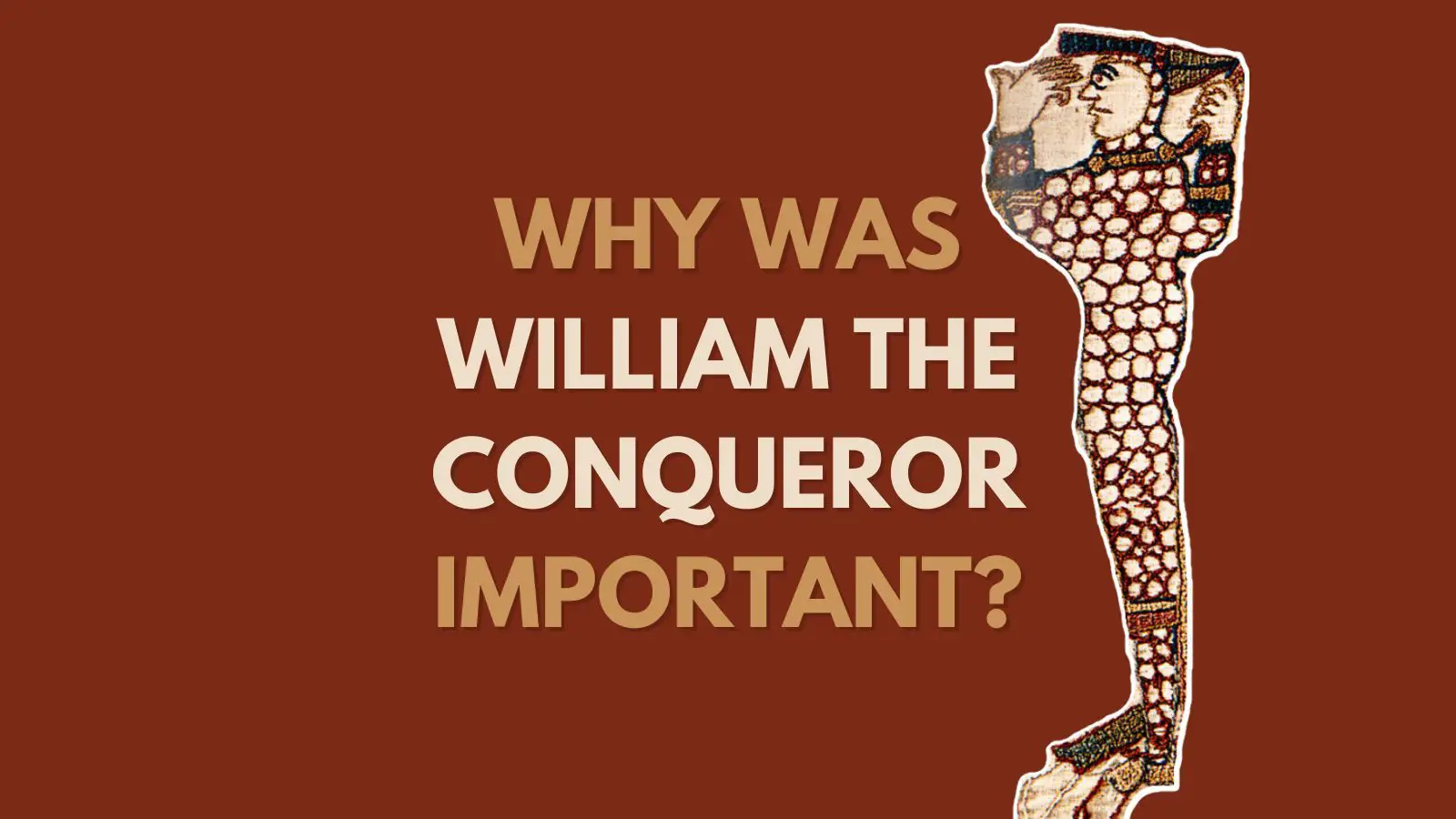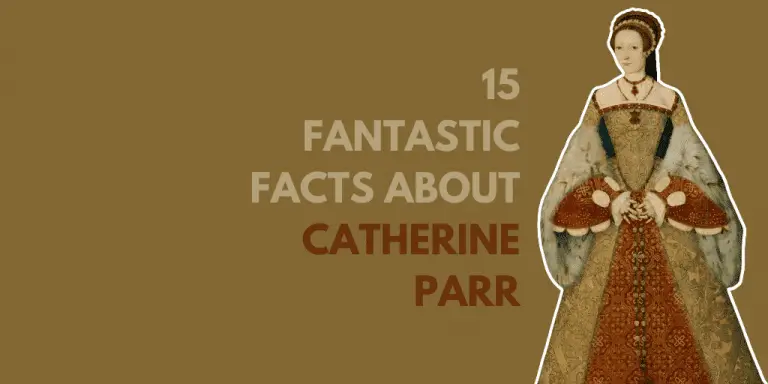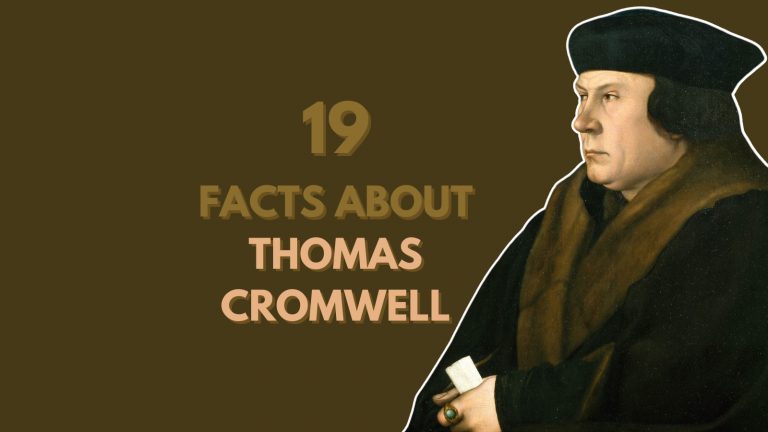[et_pb_section fb_built=”1″ _builder_version=”4.7.7″ _module_preset=”default”][et_pb_row _builder_version=”4.7.7″ _module_preset=”default”][et_pb_column type=”4_4″ _builder_version=”4.7.7″ _module_preset=”default”][et_pb_text _builder_version=”4.7.7″ _module_preset=”default”]William the Conqueror was only seven when he took up the title of Duke of Normandy and later went on to sit on the throne as King of England. Quite an accomplishment for an illiterate who could not speak English. The young William battled a violent start to his reign and it is to the credit of King Henry I of France that he even survived these early years. He was crowned king of England in 1066 following the Battle of Hastings and kept the throne until his death on September 9, 1087. He influenced the evolution of English as a language more than any person before or after him ever did or has. He was a relatively young man when he passed away in Rouen, France after 21 years on the throne.[/et_pb_text][/et_pb_column][/et_pb_row][et_pb_row _builder_version=”4.7.7″ _module_preset=”default”][et_pb_column type=”4_4″ _builder_version=”4.7.7″ _module_preset=”default”][et_pb_text _builder_version=”4.7.7″ _module_preset=”default”]
He was the first Norman king
[/et_pb_text][/et_pb_column][/et_pb_row][et_pb_row _builder_version=”4.7.7″ _module_preset=”default” column_structure=”1_5,3_5,1_5″][et_pb_column _builder_version=”4.7.7″ _module_preset=”default” type=”1_5″][/et_pb_column][et_pb_column _builder_version=”4.7.7″ _module_preset=”default” type=”3_5″][et_pb_image src=”http://historywithhenry.com/wp-content/uploads/2022/02/1-5.png” _builder_version=”4.7.7″ _module_preset=”default” alt=”William the conqueror” title_text=”1″ hover_enabled=”0″ sticky_enabled=”0″][/et_pb_image][/et_pb_column][et_pb_column _builder_version=”4.7.7″ _module_preset=”default” type=”1_5″][/et_pb_column][/et_pb_row][et_pb_row _builder_version=”4.7.7″ _module_preset=”default”][et_pb_column type=”4_4″ _builder_version=”4.7.7″ _module_preset=”default”][et_pb_text _builder_version=”4.7.7″ _module_preset=”default”]Robert I, Duke of Normandy, died without producing a legitimate son and so designated William his heir. As such, after he died in 1035 when William was only seven years old, William became duke of Normandy.[/et_pb_text][/et_pb_column][/et_pb_row][et_pb_row _builder_version=”4.7.7″ _module_preset=”default”][et_pb_column type=”4_4″ _builder_version=”4.7.7″ _module_preset=”default”][et_pb_text _builder_version=”4.7.7″ _module_preset=”default”]
He was known as William the Bastard
[/et_pb_text][/et_pb_column][/et_pb_row][et_pb_row _builder_version=”4.7.7″ _module_preset=”default”][et_pb_column type=”4_4″ _builder_version=”4.7.7″ _module_preset=”default”][et_pb_text _builder_version=”4.7.7″ _module_preset=”default”]William was the illegitimate product of Duke Robert I of Normandy’s illicit liaison with Herleva who was also known as Arlette. She was of fairly humble origins, being the daughter of a tanner in Falaise. Both Herleva and her illegitimate son were treated honourably despite this affair.[/et_pb_text][/et_pb_column][/et_pb_row][et_pb_row _builder_version=”4.7.7″ _module_preset=”default”][et_pb_column type=”4_4″ _builder_version=”4.7.7″ _module_preset=”default”][et_pb_text _builder_version=”4.7.7″ _module_preset=”default”]
Why did he believe he had a claim to the English throne?
[/et_pb_text][/et_pb_column][/et_pb_row][et_pb_row _builder_version=”4.7.7″ _module_preset=”default”][et_pb_column type=”4_4″ _builder_version=”4.7.7″ _module_preset=”default”][et_pb_text _builder_version=”4.7.7″ _module_preset=”default”]In January 1066, following the death of Edward the Confessor who was also King Edward, Harold Godwinson was proclaimed King Harold II. William immediately disputed his claim based on his claim that King Edward, being his distant cousin, had promised him the throne in 1051. Harold II was a usurper based on the fact that he had in 1064 sworn to uphold William’s right to succession. To complicate matters further, both King Harald III Hardraade of Norway and Harold’s brother, Tostig, had set their sights on England. Tostig caused King Harold to leave the English Channel undefended by launching several raids against the forces rallied by King Harold to protect the land against attacks by William. Tostig and King Harald III joined forces in September to invade England from the Scottish side. King Harold encountered, defeated, and killed them both at Stamford Bridge on 25 September. William landed in England at Pevensey just three days later.[/et_pb_text][/et_pb_column][/et_pb_row][et_pb_row _builder_version=”4.7.7″ _module_preset=”default”][et_pb_column type=”4_4″ _builder_version=”4.7.7″ _module_preset=”default”][et_pb_text _builder_version=”4.7.7″ _module_preset=”default”]
William won the battle of Hastings
[/et_pb_text][/et_pb_column][/et_pb_row][et_pb_row _builder_version=”4.7.7″ _module_preset=”default” column_structure=”1_5,3_5,1_5″][et_pb_column _builder_version=”4.7.7″ _module_preset=”default” type=”1_5″][/et_pb_column][et_pb_column _builder_version=”4.7.7″ _module_preset=”default” type=”3_5″][et_pb_image src=”http://historywithhenry.com/wp-content/uploads/2022/02/2-5.png” _builder_version=”4.7.7″ _module_preset=”default” alt=”William the conqueror” title_text=”2″ hover_enabled=”0″ sticky_enabled=”0″][/et_pb_image][/et_pb_column][et_pb_column _builder_version=”4.7.7″ _module_preset=”default” type=”1_5″][/et_pb_column][/et_pb_row][et_pb_row _builder_version=”4.7.7″ _module_preset=”default”][et_pb_column type=”4_4″ _builder_version=”4.7.7″ _module_preset=”default”][et_pb_text _builder_version=”4.7.7″ _module_preset=”default”]
The Battle of Hastings on 14 October 1066 between the army of Harold Godwinson, the last of the Anglo-Saxon kings, and William, Duke of Normandy, was decisive in the conquest of England. The Bayeux Tapestry embroidered on linen cloth uniquely depicts innumerable details representing this great battle of the Middle Ages.
William prepared for the expedition late in the summer of 1066 by gathering his soldiers in an encampment at the mouth of the river Dives. He secured the support of his Breton, Frankish, and Flemish vassals and allies, as well as getting the Pope’s blessing for his claim to the throne of England. An impressive fleet of approximately one thousand ships was constructed from the enormous forests of oak near the river. These ships transported an army of what is imagined to be 8,000 men and 5,000 horses across the sea.
William crossed the Channel unimpeded with his fleet overnight on the 28th of September 1066, making landfall on the beach of Pevensey at dawn, on the south coast of England. Harold was occupied in the north of the country in the battle against Harald Hardrada, the king of Norway, who had laid claim to the throne, too. Harold Godwinson defeated Hardrada at Stamford Bridge on the 25th of September and marched southward in haste to confront the Norman invaders. William took advantage of this time, together with his companions, to strengthen the Normans’ position by constructing a wooden stronghold at Hastings in preparation for the confrontation.
William divided his forces into 3 groups during the morning of 14 October 1066. He placed the Bretons on the left flank, the Normans in the centre, and the Franks and Flemish on the right. The duke organized and led the archers, foot soldiers, and cavalry. Harold’s troops made their way under cover of the woodland to take up position on the hilltop. From this lofty position, they discouraged soldiers approaching up the hill with missiles from above and then pushed them back in hand-to-hand combat.[/et_pb_text][/et_pb_column][/et_pb_row][et_pb_row _builder_version=”4.7.7″ _module_preset=”default”][et_pb_column type=”4_4″ _builder_version=”4.7.7″ _module_preset=”default”][et_pb_text _builder_version=”4.7.7″ _module_preset=”default”]
Bayeux Tapestry Battle of Hastings
[/et_pb_text][/et_pb_column][/et_pb_row][et_pb_row _builder_version=”4.7.7″ _module_preset=”default”][et_pb_column type=”4_4″ _builder_version=”4.7.7″ _module_preset=”default”][et_pb_text _builder_version=”4.7.7″ _module_preset=”default”]The Normans were struggling with extricating Harold’s soldiers from the hilltop, losing many of their men in the battle which started then to turn in favour of the Anglo-Saxons. A rumour that Duke William had succumbed during the fighting caused some Norman troops to retreat towards the sea, luring the English from their positions on top of the hill. William was a spectator to all this, being that he was not dead after all. He removed his helmet in front of his companions so that everybody would recognise him and know that he was alive. The Norman horsemen, close to certain defeat, returned to the front and took the upper hand in the battle.[/et_pb_text][/et_pb_column][/et_pb_row][et_pb_row _builder_version=”4.7.7″ _module_preset=”default”][et_pb_column type=”4_4″ _builder_version=”4.7.7″ _module_preset=”default”][et_pb_text _builder_version=”4.7.7″ _module_preset=”default”]
The Death Of Harold And William’s Accession
[/et_pb_text][/et_pb_column][/et_pb_row][et_pb_row _builder_version=”4.7.7″ _module_preset=”default”][et_pb_column type=”4_4″ _builder_version=”4.7.7″ _module_preset=”default”][et_pb_text _builder_version=”4.7.7″ _module_preset=”default”]
King Harold fell as evening came and he is shown in a well-known scene in the Bayeux Tapestry to be wounded by an arrow to the face. The Anglo-Saxon troops fled through the woods having eventually capitulated to repeated attacks by the Normans. William of Normandy’s men were the victors after an entire day of battle. Harold Godwinson had been killed and his troops routed, leaving the road to London wide open. William was
crowned King of England on 25 December 1066 in a ceremony at Westminster Abbey earning through his achievement the title of “the Conqueror”.[/et_pb_text][/et_pb_column][/et_pb_row][et_pb_row _builder_version=”4.7.7″ _module_preset=”default”][et_pb_column type=”4_4″ _builder_version=”4.7.7″ _module_preset=”default”][et_pb_text _builder_version=”4.7.7″ _module_preset=”default”]
The importance of Matilda of Flanders
[/et_pb_text][/et_pb_column][/et_pb_row][et_pb_row _builder_version=”4.7.7″ _module_preset=”default”][et_pb_column type=”4_4″ _builder_version=”4.7.7″ _module_preset=”default”][et_pb_text _builder_version=”4.7.7″ _module_preset=”default”]Matilda of Flanders was the wife of William I the Conqueror and Queen consort of England. Together with William, they produced ten or eleven children, two of whom were crowned king of England: William Rufus (1056–1100) and his successor Henry Beauclerc (1068–1135). Matilda acted as regent in England on behalf of William in Normandy. She was the first wife of an English king to receive her own coronation.[/et_pb_text][/et_pb_column][/et_pb_row][et_pb_row _builder_version=”4.7.7″ _module_preset=”default”][et_pb_column type=”4_4″ _builder_version=”4.7.7″ _module_preset=”default”][et_pb_text _builder_version=”4.7.7″ _module_preset=”default”]
William’s castles reinforced his rule
[/et_pb_text][/et_pb_column][/et_pb_row][et_pb_row _builder_version=”4.7.7″ _module_preset=”default”][et_pb_column type=”4_4″ _builder_version=”4.7.7″ _module_preset=”default”][et_pb_text _builder_version=”4.7.7″ _module_preset=”default”]Williams constructed a good many castles across the length and breadth of his kingdom. These served as the backbone of Norman rule throughout his kingdom and beyond. They acted as administrative centres and military bases and were central in curbing many uprisings and rebellions during his early reign in England. They were effective in controlling the landscape and intimidating his Saxon subjects into submission. Williams constructed a good many castles across the length and breadth of his kingdom. These served as the backbone of Norman rule throughout his kingdom and beyond. They acted as administrative centres and military bases and were central in curbing many uprisings and rebellions during his early reign in England. They were effective in controlling the landscape and intimidating his Saxon subjects into submission.
Besides the fact that William had defeated the last Anglo-Saxon King Harold Godwinson at the Battle of Hastings, most of the country had not seen Norman military invasion. The new Norman overlords were therefore prone to the dangers of insurrection. In fact, the earls of Mercia and Northumbria revolted in 1068. A year later, Edgar the Ætheling and the king of Denmark led an attack against William. William the Conqueror used the castles as a means to oppose military campaigns by rebels and to physically dominate the newly acquired lands. They furthermore impressed his new subjects as a display of wealth and prestige, showing his superiority as their feudal lord. The Normans brought stone castles to Britain and piloted a new age of castle construction across northern Europe.
The castle sheltered friendly troops and served as a control mechanism for its countryside and towns by upholding garrisons that could attack raiders or enemy forces. William’s castles typically started as simple wooden motte-and-bailey fortifications, converting soon enough into enormous stone keep castles, boasting state-of-the-art Romanesque architecture.
1. Pevensey Castle: Reconstruction Of A
Roman Fortification
2. Hastings Castle: Norman Invasion Base
3. The Tower Of London: Iconic Norman Keep
4. Windsor Castle: Royal Residence And Expansion
5. Norwich Castle: Expansion To East Anglia
6. Chepstow Castle: Welsh Norman Castle
7. Durham Castle: William The Conqueror Goes North
[/et_pb_text][/et_pb_column][/et_pb_row][et_pb_row _builder_version=”4.7.7″ _module_preset=”default”][et_pb_column type=”4_4″ _builder_version=”4.7.7″ _module_preset=”default”][et_pb_text _builder_version=”4.7.7″ _module_preset=”default”]
William’s Successor
[/et_pb_text][/et_pb_column][/et_pb_row][et_pb_row _builder_version=”4.7.7″ _module_preset=”default”][et_pb_column type=”4_4″ _builder_version=”4.7.7″ _module_preset=”default”][et_pb_text _builder_version=”4.7.7″ _module_preset=”default”]William fathered three sons. Robert was the oldest and in his mid-twenties, William Rufus, was about five years younger, and Henry was just nine years of age when their father died. He had delegated part of his power over Normandy to his eldest son, whom he may have named as Duke were it not for the tensions between him and Robert. Certain accounts show Robert’s younger brothers taking their father’s side against him. With the aim of playing a prank on their big brother, William Rufus and Henry took a chamber pot to the second floor of the building while all three brothers were home together. Robert was playing the military game of dice with his friends in the gallery below when the younger two brothers dumped water on their heads from above. Robert’s friends took this as an insult and an enraged Robert made his way to confront them in the banquet hall. King William was however attracted by the mayhem and sorted out the quarrel between the boys. The following night, Robert and his friends took revenge by seizing the castle of Rouen. However, the king’s butler thwarted their plot and King William became aware of their rebellion, which he moved to crush, causing Robert to flee Normandy. Even though the situation calmed after a year, the bitterness between William and Robert persisted, leading to further rebellions.
The dispute persisted even after William’s death in 1087 when William Rufus took over the kingdom with Robert remaining the Duke of Normandy. Wars waged within the family, culminating with Henry capturing Robert at the Battle of Tinchebrai in 1106. Henry went on to rule England and Normandy, while Robert remained a prisoner for the rest of his life.[/et_pb_text][/et_pb_column][/et_pb_row][et_pb_row _builder_version=”4.7.7″ _module_preset=”default”][et_pb_column type=”4_4″ _builder_version=”4.7.7″ _module_preset=”default”][et_pb_text _builder_version=”4.7.7″ _module_preset=”default”]
William the Conqueror’s odd demise
[/et_pb_text][/et_pb_column][/et_pb_row][et_pb_row _builder_version=”4.7.7″ _module_preset=”default” column_structure=”1_5,3_5,1_5″][et_pb_column _builder_version=”4.7.7″ _module_preset=”default” type=”1_5″][/et_pb_column][et_pb_column _builder_version=”4.7.7″ _module_preset=”default” type=”3_5″][et_pb_image src=”http://historywithhenry.com/wp-content/uploads/2022/02/3-4.jpg” _builder_version=”4.7.7″ _module_preset=”default” alt=”William the conqueror” title_text=”3″ hover_enabled=”0″ sticky_enabled=”0″][/et_pb_image][/et_pb_column][et_pb_column _builder_version=”4.7.7″ _module_preset=”default” type=”1_5″][/et_pb_column][/et_pb_row][et_pb_row _builder_version=”4.7.7″ _module_preset=”default”][et_pb_column type=”4_4″ _builder_version=”4.7.7″ _module_preset=”default”][et_pb_text _builder_version=”4.7.7″ _module_preset=”default”]William was in the throes of capturing the French town of Mantes when, while on horseback, he was thrown against the pommel of his saddle, rupturing his internal organs. William retreated to his capital at Rouen where his condition worsened, he confessed his sins and sought pardon.[/et_pb_text][/et_pb_column][/et_pb_row][et_pb_row _builder_version=”4.7.7″ _module_preset=”default”][et_pb_column type=”4_4″ _builder_version=”4.7.7″ _module_preset=”default”][et_pb_text _builder_version=”4.7.7″ _module_preset=”default”]
William’s legacy
[/et_pb_text][/et_pb_column][/et_pb_row][et_pb_row _builder_version=”4.7.7″ _module_preset=”default”][et_pb_column type=”4_4″ _builder_version=”4.7.7″ _module_preset=”default”][et_pb_text _builder_version=”4.7.7″ _module_preset=”default”]William’s conquest had a profound impact on England, and the changes he wrought have persisted to today, such as those in the Church, aristocracy, culture, and language of the country. The kingdom was brought into closer contact with France and the ties forged between France and England persisted throughout the Middle Ages. England’s relationship with France after 1066 has persisted. Norman-French became the language of the upper class, the court, and the government, remaining so for nearly three hundred years. Norman words are still in common use to this day, among them purchase, beef, pork, and noble. As for dietary influences, cider so strongly connected with the South West of England today, is actually a Norman import. Rabbits were successfully introduced to the British Isles by the Normans and this meat was regarded as a delicacy among the wealthy. The advent of surnames is also thanks to the Normans since the Anglo-Saxons had nicknames or names derived from their paternity, but not actual inherited surnames.
Of course, William changed the very countryside of England with the introduction of their very first castles in 1066. The Saxons had fortified towns before this, built as a refuge for their communities, and these were the closest Britain had to fortifications up until the arrival of the Normans. The network of vast stone castles William had built allowed England an iron grip as instruments of power that stamped Norman authority on the very land.[/et_pb_text][/et_pb_column][/et_pb_row][/et_pb_section]






